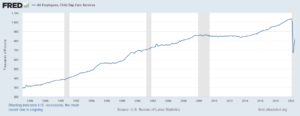Economists and investors are searching for the new normal, or the economy of the post-pandemic world.
Zoom meetings will be a permanent feature for many in the new normal. But the majority of workers can’t rely on Zoom because they can’t work from home.
According to a Stanford researcher:
We see an incredible 42% of the U.S. labor force now working from home full-time. About another 33% are not working — a testament to the savage impact of the lockdown recession. And the remaining 26% — mostly essential service workers — are working on their business premises. So, by sheer numbers, the U.S. is a working-from-home economy. Almost twice as many employees are working from home as at work.
Work from home is a success if we ignore the fact that 58% of the labor force needs a place to work. Getting the majority back to work poses some problems.
An economist with the Federal Reserve Bank of Minneapolis identified one problem in an unwieldly-titled paper, “Why Is Mommy So Stressed? Estimating the Immediate Impact of the COVID-19 Shock on Parental Attachment to the Labor Market and the Double Bind of Mothers.”
Here’s a snippet related to the Zoom hypothesis:
Parents — especially mothers — remain ever vulnerable to the availability of affordable childcare while they work. Without these systems, mommy will forever be stressed and vulnerable to career scarring during any major crisis like this pandemic…
Getting America back to work requires open day care facilities. This sector was among the hardest hit in the shutdown. Check out the chart below.
Day Care Jobs: Massive COVID-19 Unemployment

Source: Federal Reserve
Day care services sectors have lost more than a decade’s worth of employment gains. Jobs are back to 2006 levels.
What Day Care Jobs Mean for the Economic Recovery
This sector provides jobs for many. It also allows others to return to jobs.
And it’s a sector that is in crisis.
According to a recent National Association for the Education of Young Children survey, 40% of child care providers expect to close without government help.
Day cares are a sign of normalcy. These facilities allow others to work, and they aren’t available in some places.
Investors need to look past retail sales and employment data. They need to think about whether or not their local communities are back to normal.
If the answer is no, the same is true in many communities.
Until you see people living normal lives where you live, expect a second down leg in the stock market.
Michael Carr is a Chartered Market Technician for Banyan Hill Publishing and the Editor of One Trade, Peak Velocity Trader and Precision Profits. He teaches technical analysis and quantitative technical analysis at New York Institute of Finance. Mr. Carr is also the former editor of the CMT Association newsletter, Technically Speaking.
Follow him on Twitter @MichaelCarrGuru.




